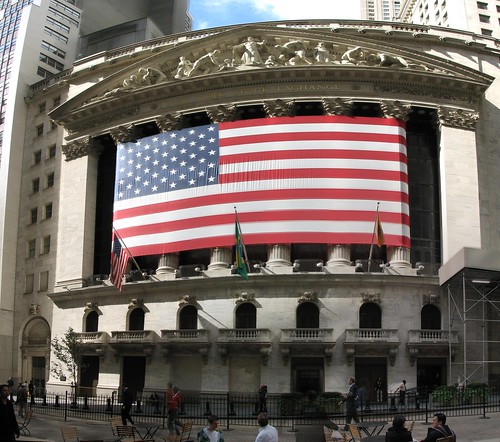Exchange Traded Funds are created to gain broad market exposure, like mutual funds, that individual investors could not have achieved on their own. But built upon mutual funds, exchange traded funds actually combine different features of different types of mutual funds to make them available all in one single ETF, namely the valuation feature of open-end mutual funds and the tradability feature of closed-end funds.
[Read more…] about Exchange Traded Funds – Pros and Cons
Investing
10 Free Investment Credits From ShareBuilder (And $50 Signup Bonus)
Online investment company ShareBuilder (owned by ING Direct) is offering up 10 free investment credits to new and existing customers who set up an Automatic Investment Plan before January 31st. This is a great way to start investing for the New Year! Normally automatic investments are $4 per trade.
[Read more…] about 10 Free Investment Credits From ShareBuilder (And $50 Signup Bonus)
What Is The Dow?
What Is The Dow Jones Industrial Average?
We’ve hear a lot about the Dow in the news. It goes up and folks are happy. It goes down and folks panic. But what is this mystical Dow that everyone is talking about?
The Dow actually stand for Dow Jones Industrial Average. It’s made up of the 30 largest and most widely held public companies. The average is a scaled average which is price weighted to account for stock splits. Although it only accounts for 30 companies, the Dow has historically been in line with the larger US market. For this reason it tends to be the most common indicator of the market in general.
The Dow was first published in 1896 and consisted of 12 companies:
- American Cotton Oil Company
- American Sugar Company
- American Tobacco Company
- Chicago Gas Company
- Distilling and Cattle Feeding Company
- General Electric
- Laclede Gas Light Company
- National Lead Company
- North American Company
- Tennessee Coal, Iron, and Rail company
- US Leather Company
- Unites States Rubber Company
Today’s Dow looks very different:
| 3M | |||
| Alcoa | |||
| American Express | |||
| AT&T | |||
| Bank of America | |||
| Boeing | |||
| Caterpillar | |||
| Chevron Corporation | |||
| Citigroup | |||
| Coca-Cola | |||
| DuPont | |||
| ExxonMobil | |||
| General Electric | |||
| General Motors | |||
| Hewlett-Packard | |||
| Home Depot | |||
| Intel | |||
| IBM | |||
| Johnson & Johnson | |||
| JPMorgan Chase | |||
| Kraft Foods | |||
| McDonald’s | |||
| Merck | |||
| Microsoft | |||
| Pfizer | |||
| Procter & Gamble | |||
| United Technologies Corporation | |||
| Verizon Communications | |||
| Walmart | |||
| Walt Disney |
Update – On June 8, 2009 GM and Citigroup were replaced by The Travelers Companies and Cisco Systems.
When it started the Dow averaged 40.94. It’s recent high was 14,164.53 on October 9, 2007.
Why is it so important?
Since the Dow represents 30 of the largest US companies, changes in the stock prices of the Dow can be seen to represent the general health of US companies. Higher averages mean growth and profits while lower averages represent contraction and losses.
Do you follow Dow prices? Do you think it’s an accurate economic indicator?
![]() photo credit: epicharmus
photo credit: epicharmus
I Re-Allocated And Re-Balanced My 401(k) Portfolio
I logged into my 401(k) plan. Ouch! It’s been taking a beating all year. In fact I mentioned that my 401(k) was hurting back in December when Hank over at MiB Smarter Money gave me a nice analysis of my portfolio. Now, I understand that I’m in this for the long haul as far as the investments are concerned. After all this is for my retirement which is still a ways off. There’s plenty of time for the investments to recover and do well. I’m not going to pull my money out because the market isn’t great. The only reason my contributions were lowered is because we’re a one-income family right now (I only lowered my contributions down to the company match).
So I accept that my 401(k) isn’t so hot. Now what? Well, I’ve been reading The Bogleheads’ Guide to Investing (which I won from The Digerati Life). I’m not done with the book (which, by the way, is a great how-to investing read) but I have read how important it is to have a good asset allocation and to re-balance your portfolio from time to time.
This made me wonder what my portfolio looked like. I set up how I wanted my assets allocated when I started contributing and I’ve made a few adjustments from time to time. But reading the Boglehead book made me re-think what my allocations should be. Also, I haven’t re-balanced the portfolio in the longest time. I’ve changed my future contributions but rarely what was already in there.
So today I changed that. Looking at my portfolio I realized I had funds that I was no longer contributing to but still had large balances. I also saw that based on suggested portfolios in the book and my age that I should probably have a higher percentage of bonds in my investments. Other funds that I was contributing a higher % to really took up a very small % in my portfolio since I haven’t been re-balancing.
First, I changed where my future contributions will be going. This is money that comes out of my check as well as the company match. Next, I moved investments already in my portfolio to match my new asset allocation. Both processes were pretty easy on the Fidelity site (the company that manages the 401k). Remember, changing your future contributions isn’t the same as re-balancing your portfolio. You have to look at both if you want it truly balanced to the investments of your choice.
Here’s what the allocation is now:
Stocks
Large Cap
- Fidelity Contrafund 18%
- Vanguard Institutional Index Fund Institutional Shares 22%
Mid Cap
- Artisan Mid Cap Inv CL 10%
Small Cap
-
Fidelity Small Cap Stock Fund 10%
International
-
American Funds New Perspective Fund Class R5 5%
-
Fidelity Diversified International Fund 5%
Bond/Managed Income
-
PIMCO Total Return Inst CL 30%
Before I started changing anything I made sure that there would be no fees for changing investments. Some funds charge a fee if you sell them before a certain time frame.
I also set up my account to send me an email if any of my percentages exceed 5% of what I set. This gives me a reminder to check if I want to re-balance the funds that changed.
I’m not expecting my portfolio to all of a sudden jump into the black but it will be interesting to look and see where it’s at year-end. Again, these funds are for the long haul as I won’t use them until I retire. That said, I still need to adjust my contributions and allocations as time goes on.
Sign up with ING Direct and get a $25 bonus – Free From Broke
![]() photo credit: James Jordan
photo credit: James Jordan
A CD Ladder Plan For Beginning Savers
 Are you just starting off building up your savings? I’ve mentioned before that a great way to save is by putting money in a high yield savings account such as Capital One 360 Savings. A way to make a little more interest is to open a Certificate of Deposit, or CD for short.
Are you just starting off building up your savings? I’ve mentioned before that a great way to save is by putting money in a high yield savings account such as Capital One 360 Savings. A way to make a little more interest is to open a Certificate of Deposit, or CD for short.
What is a CD?
Here’s an excerpt from Wikipedia:
A certificate of deposit or CD is a time deposit, a financial product commonly offered to consumers by banks, thrift institutions, and credit unions.
CDs are similar to savings accounts in that they are insured and thus virtually risk-free; they are “money in the bank” (CDs are insured by the FDIC for banks or by the NCUA for credit unions). They are different from savings accounts in that the CD has a specific, fixed term (often three months, six months, or one to five years), and, usually, a fixed interest rate. It is intended that the CD be held until maturity, at which time the money may be withdrawn together with the accrued interest.
So if you are investing/buying a CD you want to make sure you don’t need that money for the length of it’s term (otherwise you will have to pay a penalty to cash it in).
Here’s a great way a beginning saver can get started with CD’s:
- Figure out a monthly amount of money you know you won’t need for 12 months. Don’t be scared now. It can be a small amount like $10.
- Log into your ING account and go to their products page. Click on CD’s and proceed to open up a $10 CD for a 12-month term. (If you can afford more by all means do so. Remember this is money you won’t touch for a year.)
- Now every month do the same thing for a total of 12 months.
- At the end of a year you will have 12 CDs worth more than $120 (imagine if you put more in each month?). If you can, re-invest the CDs as they mature. See if you can add to the amounts, again even if it’s only a few dollars.
“What have we done? Anyone can buy CDs!”, you may ask? Remember this is for a beginner who is starting to build up their savings. Here is what the beginning saver has accomplished:
- This builds up a habit of saving. By putting the money in a CD we’re limiting the ability to take the money out (without a penalty at least). Once this habit is in place a beginning saver may have the discipline to expand their savings.
- It creates a great sense of self-esteem for the saver. You get to see your CDs growing every month. How great is it to see a year’s worth of savings? Once a person realizes that saving is an achievable goal they will be more likely to continue!
- You’re earning interest. Not only have you saved but you’re savings are growing too! You’re taking advantage of laddering.
Savings aren’t usually built overnight. But by saving bit by bit you will see your savings blossom over time!
photo credit: naama



